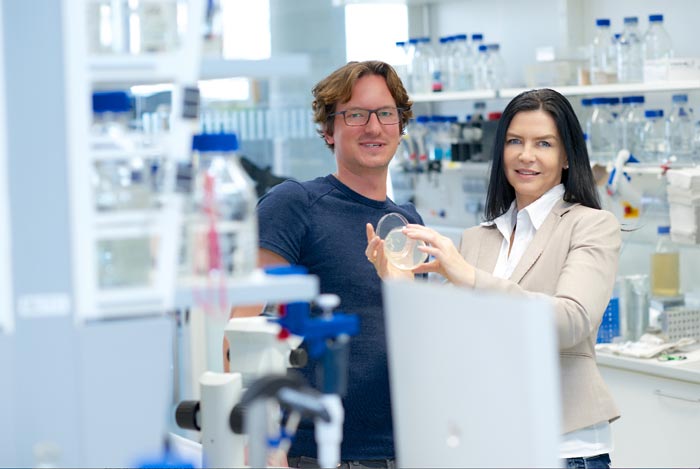How proteins find the right path

photo of Prof. Dr. Elke Deuerling and Dr. Martin Gamerdinger
A package arriving at the wrong address causes confusion, in many cases leading to stress. This concept also applies to protein transport in living cells. The team around the Konstanz-based biologist Professor Elke Deuerling, who also is the speaker for the Collaborative Research Centre “Chemical and Biological Principles of Cellular Proteostasis” (SFB 969), has now discovered exactly what is necessary to prevent erroneous protein transport.
Two competing activities ensure that proteins safely arrive at their intended destination – in cell organelles like the mitochondria and the endoplasmic reticulum (ER), in particular. The team succeeded in uncovering that, in contrast to the prevailing view, successful protein transport requires not only the signal recognition particle (SRP), but also the nascent polypeptide-associated complex (NAC). The elucidation of this fundamental cellular process may have far-reaching implications for research on age-related defects and diseases, such as Alzheimer’s. The study’s results were published 10 April 2015 in “Science.”
In 1999, Günter Blobel was awarded the Nobel Prize for Medicine for the discovery of the signal recognition particle (SRP) pathway that sorts and delivers proteins to the ER. Within the SFB 969, Dr. Martin Gamerdinger now was able to prove that also the protein complex NAC is necessary for accurate protein sorting by inhibiting the transport of non-authentic proteins into the ER. “Until now,” states Martin Gamerdinger, “it was generally believed that solely the signal recognition particle fulfills the critical role in correct protein transport by stimulating the process. We discovered, however, that the process also must be inhibited in order to prevent erroneous protein targeting.” Evidence for this antagonistic principle was collected with the help of an experimental set-up using the nematode C. elegans and reducing the level of NAC. Martin Gamerdinger comments: “We observed, that in the absence of NAC, the animals experience stress in the ER as well as in mitochondria and live only half as long.”
Elke Deuerling compares NAC with ticket checkers who let people into football games, concerts or the cinema based on the kind of ticket. This controlling function is crucial because ribosomes that produce proteins tend to bind the membrane of the endoplasmic reticulum unspecifically. Without NAC, a part of the proteins being produced by ribosomes mistakenly end up in the ER. “NAC acts as a shield between the ribosome and the endoplasmic reticulum. Only once a protein leaves the ribosome with the right signal or “ticket” for the ER, the signal recognition particle appears to push aside the NAC complex and the protein can enter the ER. The transport only correctly works when the balance between SRP and the NAC complex is right,” explains Elke Deuerling.
Proteins ending up in the wrong location, not only disturb the homeostasis in the endoplasmic reticulum, but also in mitochondria, because proteins specific to them don’t arrive in the mitochondria, but rather in the endoplasmic reticulum. “This creates an enormous stress in the organism and leads to a drastically shortened lifespan of C. elegans,” says the molecular biologist.
The protein complex NAC is essential for all higher cells, also in humans. For this reason, it was impossible to “turn off” the NAC genes, since this would lead to immediate cell death. Instead of the “knock-out” method, Martin Gamerdinger utilized the “knock-down” principle by simply reducing the NAC levels. Elke Deuerling adds: “The trick was to choose the right model organism, C. elegans. We were able to achieve our results by combining a variety of scientific techniques – biochemical approaches, the establishment of new transgenic C. elegans strains and high-resolution microscopy – and with the additional support of my doctoral student Anne Hanebuth and the applied bioinformatics Junior Professor Tancred Frickey.”
Original Publication:
Martin Gamerdinger, Marie Anne Hanebuth, Tancred Frickey, Elke Deuerling: “The principle of antagonism ensures protein targeting specificity at the endoplasmic reticulum”. In: Science, 10. April 2015, Issue 34, No. 6231.
Contact:
University of Konstanz
Communications and Marketing
Phone: +49 7531 88-3603
E-mail: kum@uni-konstanz.de
Prof. Elke Deuerling
University of Konstanz
Molecular Biology
Universitätsstraße 10
78464 Konstanz
Phone: +49 7531 88-2647
E-mail: elke.deuerling@uni-konstanz.de
Media Contact
All latest news from the category: Life Sciences and Chemistry
Articles and reports from the Life Sciences and chemistry area deal with applied and basic research into modern biology, chemistry and human medicine.
Valuable information can be found on a range of life sciences fields including bacteriology, biochemistry, bionics, bioinformatics, biophysics, biotechnology, genetics, geobotany, human biology, marine biology, microbiology, molecular biology, cellular biology, zoology, bioinorganic chemistry, microchemistry and environmental chemistry.
Newest articles

Properties of new materials for microchips
… can now be measured well. Reseachers of Delft University of Technology demonstrated measuring performance properties of ultrathin silicon membranes. Making ever smaller and more powerful chips requires new ultrathin…

Floating solar’s potential
… to support sustainable development by addressing climate, water, and energy goals holistically. A new study published this week in Nature Energy raises the potential for floating solar photovoltaics (FPV)…

Skyrmions move at record speeds
… a step towards the computing of the future. An international research team led by scientists from the CNRS1 has discovered that the magnetic nanobubbles2 known as skyrmions can be…





















